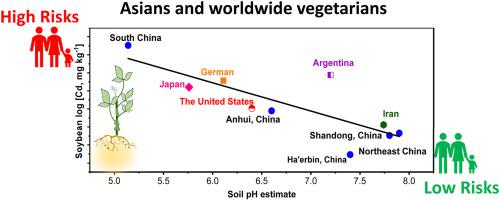Environmental Pollution ( IF 7.6 ) Pub Date : 2020-11-27 , DOI: 10.1016/j.envpol.2020.116153 Sha Zhang 1 , Jing Song 2 , Longhua Wu 2 , Zheng Chen 3

|
Elevated toxins in soybeans extensively threaten Asian residents and over one billion vegetarians worldwide. An integrated dataset of toxic trace metal(loid)s especially cadmium (Cd) analysis in soybean grain samples (n = 5217) from 12 countries/regions of origin was compiled for risk analysis. Worldwide grain Cd averaged 0.093 mg kg-1, but mean values varied 16-fold between regions, with South China (0.32 mg kg-1) > Argentina (0.15 mg kg-1) = German (0.13 mg kg-1) > Japan (0.11 mg kg-1) > the United States (0.064 mg kg-1) > Central-North China (0.020-0.60 mg kg-1) ≥ Iran (0.042 mg kg-1) = Brazil (0.023 mg kg-1) = South Korea (0.020 mg kg-1). Regression analysis suggested widespread contamination and acidic soil features significantly contributed the elevated food Cd contamination worldwide. Arsenic (As) and lead (Pb) are also of concern because excessive levels were often observed in grains. Given that soil Cd bioavailability is generally low in alkaline pH ranges, the feasibility of producing safe food from contaminated land was investigated by greenhouse experiments with one low-Cd soybean cultivar grown on 20 contaminated calcareous soils. Equilibrium-based approaches i.e., 0.01 M CaCl2 and in-situ porewater extractions, and diffusion-based diffusive gradients in thin-films technique were used to determine the plant-available fractions of soil metal(loid)s to explain the bioaccumulation variation. The results suggested that soybean grains bioaccumulated mean 0.76 mg Cd kg-1, ranging from 0.16 to 2.1 mg kg-1, whereas As and Pb bioaccumulation was low. Cadmium accumulation was closely correlated with plant-available Cd fractions especially the 0.01 M CaCl2-extractable Cd, but negatively correlated with soil pH. Even in the alkaline pH range, a slight decrease of soil pH would increase grain Cd significantly. Study region and those arable lands that have similar soil conditions are not recommended for growing soybean unless novel remediation strategies are developed.
中文翻译:

全球大豆籽粒中镉的积累及受污染钙质土壤食品生产的可行性
大豆中毒素含量升高广泛威胁着亚洲居民和全球超过十亿素食者。编制了来自 12 个国家/地区的大豆籽粒样品 (n = 5217) 中有毒微量金属(尤其是镉 (Cd))分析的综合数据集,用于风险分析。全球谷物镉平均含量为0.093 mg kg -1 ,但地区间平均值相差16倍,其中华南(0.32 mg kg -1 )>阿根廷(0.15 mg kg -1 )=德国(0.13 mg kg -1 )>日本(0.11 mg·kg -1 )>美国(0.064 mg·kg -1 )>中北地区(0.020-0.60 mg·kg -1 )≥伊朗(0.042 mg·kg -1 )=巴西(0.023 mg·kg -1 ) = 韩国(0.020 mg kg -1 )。回归分析表明,广泛的污染和酸性土壤特征在很大程度上导致了全球食品镉污染的增加。砷 (As) 和铅 (Pb) 也令人担忧,因为谷物中的砷 (As) 和铅 (Pb) 含量经常超标。鉴于土壤镉的生物有效性在碱性 pH 范围内普遍较低,通过温室实验,在 20 块受污染的钙质土壤上种植一种低镉大豆品种,研究了从受污染土地生产安全食品的可行性。基于平衡的方法,即0.01 M CaCl 2和原位孔隙水提取,以及薄膜技术中基于扩散的扩散梯度被用来确定土壤金属(类)的植物可利用部分,以解释生物累积变化。结果表明,大豆籽粒的平均生物富集量为0.76 mg Cd kg -1 ,范围为0.16~2。1 mg kg -1 ,而As和Pb的生物累积量较低。镉的积累与植物可利用的镉组分尤其是0.01 M CaCl 2可提取的镉密切相关,但与土壤pH值呈负相关。即使在碱性pH范围内,土壤pH值的轻微降低也会使籽粒中的Cd显着增加。除非制定新的修复策略,否则不建议研究区域和具有类似土壤条件的耕地种植大豆。











































 京公网安备 11010802027423号
京公网安备 11010802027423号